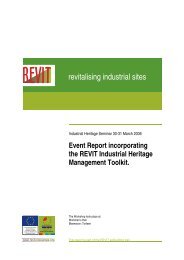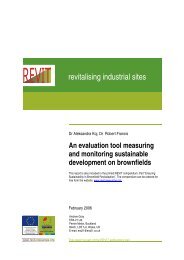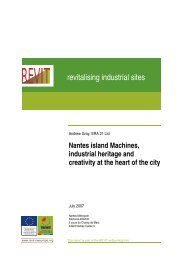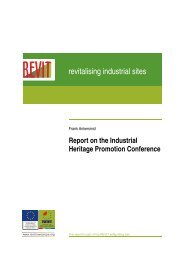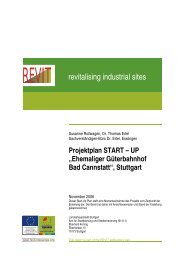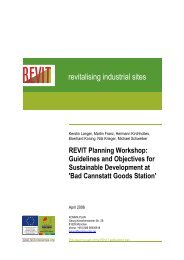REVIT Heritage Report.pdf
REVIT Heritage Report.pdf
REVIT Heritage Report.pdf
Create successful ePaper yourself
Turn your PDF publications into a flip-book with our unique Google optimized e-Paper software.
Torfaen County Borough Council<br />
<strong>REVIT</strong>: A Review of the Conservation of Industrial <strong>Heritage</strong> Assets on Brownfield Sites<br />
4.2.28 At the time of its construction it was one of the largest ironworks in the world<br />
and is the best preserved blast furnace complex of its period and type in the<br />
world. The ironworks site has been conserved to emphasise its authenticity as<br />
a consolidated ruin, preserving its surviving features. Therefore, no<br />
reconstruction has taken place except where necessary for structural purposes<br />
and wherever possible, all conservation measures are devised to be<br />
reversible.<br />
4.2.29 One of the most impressive monuments at Blaenavon Ironworks is the water<br />
balance tower which was built in 1839. This form of lift technology using water<br />
to counter-balance loads was used in the mine shafts of south east Wales and<br />
at several ironworks. This site is one of the best preserved surviving examples.<br />
4.2.30 Adjacent to the Ironworks stands Stack Square and Engine Row, a small group<br />
of solidly constructed stone cottages, incorporating patterns of building, notably<br />
door and window heads, characteristic of the West Midlands in England<br />
alongside more local building practices. The houses were probably erected in<br />
1788 for the first skilled workers who operated the furnaces from the time they<br />
were built. The houses form a square with the central range originally forming<br />
the Company office, shop and manager's house, until it was converted to<br />
dwellings in the 1860s. The whole square is a Scheduled Ancient Monument<br />
which has been carefully conserved.<br />
4.2.31 There are a number of community buildings within Blaenavon, such as the<br />
church of St Peter, built in the Gothic style in 1804 by the ironmasters Thomas<br />
Hill and Samuel Hopkins, and the Blaenavon's Workmen's Hall and Institute.<br />
The latter is the most imposing building in the town and was designed by E. A.<br />
Lansdowne of Newport and opened in 1895.<br />
4.2.32 At nearby Cwmavon, there was a forge linked with Blaenavon Ironworks which<br />
carried out the puddling process, operated from about 1804; there are no<br />
surviving remains above ground. A terrace of twelve dwellings which was built<br />
for the forge workers in 1804, was repaired by the British Historic Buildings<br />
Trust in 1987-88; it has been described as the finest surviving terrace of early<br />
workers'housing in the South Wales Valleys. The more substantial, Cwmavon<br />
House, was built for the ironmaster in the 1820s.<br />
Tourism<br />
4.2.33 In addition to the Blaenvaon landscape there are a number of other industrial<br />
era attractions within the vicinity including:<br />
• Five locks, Cwmbran, M&B Canal;<br />
• Glyn Pitts, Pontypool;<br />
• Griffithstown Railway Museum;<br />
• <strong>Heritage</strong> and Cordell Museum;<br />
• Hill's Pits chimney, BWHS;<br />
• Lower Navigation Colliery Engine House;<br />
• Pontymoile Basin, Pontypool - Toll House & aqueduct, M&B Canal;<br />
• Pontypool heritage townscape;<br />
• Pontypool and Blaenavon Railway; and<br />
0014021/JM/001 23




